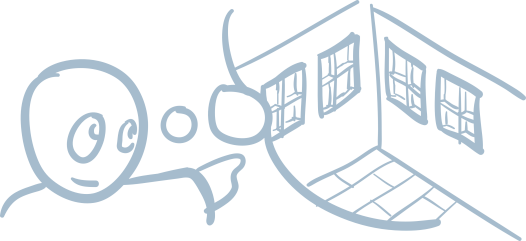Building schemata: children know more than we have taught them
Do you know how many windows there are in your house? Probably not by heart... but if you give it some thought, you will be able to come up with an answer. And your answer will be correct. That is because you have a schema - in other words, a plan - of the house in your mind. Children also have schemata in their minds. The Hejny method strengthens and interlinks these schemata, and infers general patterns from them. Children soon realize that half is also a number (0.5), and they do not find commonly “problematic” fractions problematic at all.
In real life, as well as in mathematics, mental schemata are main instrumental in decision-making. They permeate human thought and action; they determine what we set as our goals and how we evaluate. Many patterns that relate to the schemata of our everyday lives also relate to mathematical schemata.

What is a schema?
In very simple terms, a schema is a collection of interrelated pieces of knowledge that we have about a familiar environment. The following illustration will help to explain this further:
If someone asked you how many doors or carpets you have in your house, you probably couldn’t come up with an immediate answer. Yet after a moment’s thought you would be able to answer with confidence. You would have taken a mental walk through all the rooms and counted the relevant objects. These facts, along with many more pieces of information, are stored (just in case) in your mind, as a set of information that we call the schema of your house.
The schema of a house is constructed gradually, as a result of the activities that you do in the house. Different people perceive the same environment differently: the relevant schemata in their minds differ, even though the environment is identical. Activities take place in time but schemata change only little by little. House-related activities that we focus on (e.g. repairing something in the house) contribute to the development of the house schema more than activities that are centered around a different object (e.g. watching TV).
There are a whole range of schemata in our minds: the schemata of our house, the town we live in, the building we work in, the shopping center we shop in, the set of our relatives, the set of our friends, the collection of books in our bookcase , and so on. Each of these environments contains a large number of objects, relationships and sub-schemata. Each environment has unique characteristics, but many of the more general objects, concepts and relationships will be found in various environments and their schemata. For instance, the relationship “like” is not only present in the schema of interpersonal relationships, but also in the house schema because we like certain places or things in it.
Our method uses schemata such as a bus, walking, family, and so on: schemata that we have all formed on our own during our childhood. Using these schemata, children are able to discover the world independently and acquire autonomous knowledge, which is of lasting value for them.
Mathematical schema
A basic mathematical schema is the first more general understanding that originates from several concrete experiences; it is usually accompanied by the aha-effect.
Mathematical schemata are strongly interrelated. For example, the schema of the rational number concept emerges from linking the schemata of natural number, fraction, decimal number, and negative number concepts.
Moments of discovery and internal tension are decisive in the process of refining a schema. Think, for instance, of a 6 year old who has just found out that a half is a number, or of a 10 year old who discovers that a quadrilateral does not have to be convex, or that it is possible to form a triangle with an arbitrarily long perimeter and an infinitessimally small area. In practice, these formative moments of internal tension most often occur in class as a result of discussion about the difference between various pupils’ opinions.
General characteristics of schemata
- Schemata are usually formed spontaneously, as a consequence of the person’s needs. If there is no need, the schema will not be formed.
- Schemata of one and the same thing will differ in different people’s minds. These differences can lead to misunderstandings.
- People who solve a problem together can, through interaction, find a better solution than they would have, had they solved the problem individually. Furthermore, a person who knows about other people’s schemata can make use of their knowledge.
- When something appears in a schema at an opportune moment and repeatedly, it will persist there for a long time. When something appears at an unsuitable moment or comes up only seldom, it will soon disappear from the schema.
- Parts of a schema that are only infrequently used need to be accessible in external memory so that they can be accessed when necessary. External memory frees up intellectual energy for more demanding tasks.
Teaching based on building schemata
Building schemata of mathematical concepts, phenomena, processes and situations in the mind of each pupil is what lies at the heart of a teaching method that strives to maximize autonomy in the pupil’s learning process. This method can be referred to as Schema-oriented Education, and is commonly known as Hejny method.
